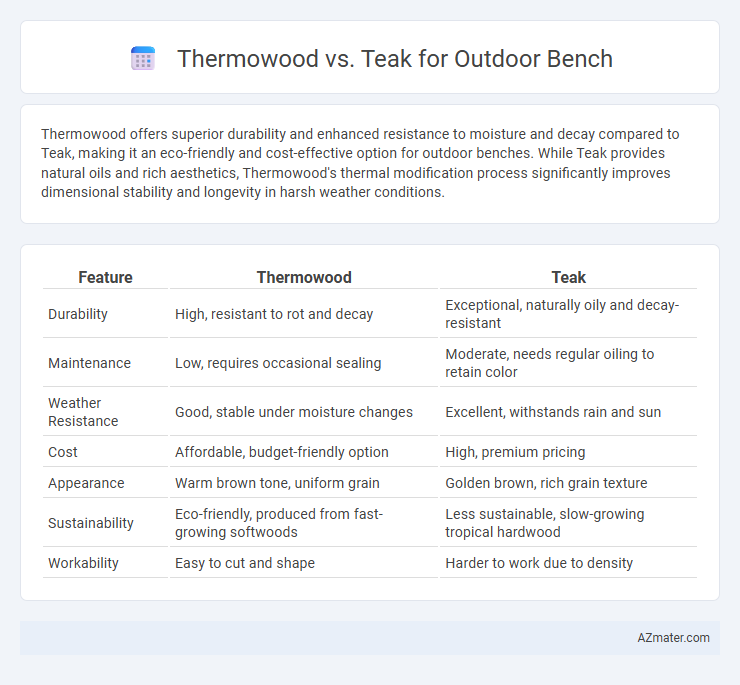Thermowood offers superior durability and enhanced resistance to moisture and decay compared to Teak, making it an eco-friendly and cost-effective option for outdoor benches. While Teak provides natural oils and rich aesthetics, Thermowood's thermal modification process significantly improves dimensional stability and longevity in harsh weather conditions.
Table of Comparison
| Feature | Thermowood | Teak |
|---|---|---|
| Durability | High, resistant to rot and decay | Exceptional, naturally oily and decay-resistant |
| Maintenance | Low, requires occasional sealing | Moderate, needs regular oiling to retain color |
| Weather Resistance | Good, stable under moisture changes | Excellent, withstands rain and sun |
| Cost | Affordable, budget-friendly option | High, premium pricing |
| Appearance | Warm brown tone, uniform grain | Golden brown, rich grain texture |
| Sustainability | Eco-friendly, produced from fast-growing softwoods | Less sustainable, slow-growing tropical hardwood |
| Workability | Easy to cut and shape | Harder to work due to density |
Introduction to Thermowood and Teak
Thermowood is a sustainable, heat-treated softwood known for enhanced durability and resistance to decay, making it an eco-friendly choice for outdoor benches. Teak is a dense hardwood prized for its natural oils and high resistance to moisture, fungi, and insects, ensuring long-lasting outdoor performance. Both materials offer unique benefits in weather resistance and maintenance, with Thermowood emphasizing environmental impact and Teak highlighting premium durability.
Key Differences in Origin and Production
Thermowood is produced from Scandinavian softwoods like pine or spruce through a heat treatment process that enhances durability and stability without chemicals, while teak is a naturally dense hardwood native to Southeast Asia, prized for its natural oils and resistance to decay. The heat treatment in Thermowood alters the wood's cellular structure, reducing moisture absorption and making it more resistant to outdoor conditions but less oily and aromatic compared to teak. Teak's natural oils provide superior protection from insects and water, making it inherently weather-resistant, whereas Thermowood relies on the thermal modification process to achieve enhanced outdoor performance.
Durability and Weather Resistance
Thermowood offers exceptional durability and weather resistance due to its heat treatment process, which enhances dimensional stability and reduces moisture absorption. Teak, naturally rich in oils and dense grain, provides superior resistance to decay, insects, and harsh weather, maintaining its strength and appearance over time. Both woods perform well outdoors, but Thermowood's eco-friendly treatment and teak's innate durability make them top choices for long-lasting outdoor benches.
Maintenance Requirements
Thermowood requires minimal maintenance due to its heat-treatment process, which enhances durability and resistance to decay, reducing the need for frequent sealing or staining compared to traditional woods. Teak naturally contains oils that protect it from moisture and insects, but it still demands regular oiling or sealing to maintain its rich color and prevent weathering. Both woods benefit from seasonal cleaning, yet Thermowood's treated surface offers a longer-lasting finish with less intensive upkeep than teak.
Aesthetic Appeal and Color Changes
Thermowood exhibits a warm, reddish-brown hue that gracefully darkens over time to a rich chocolate brown, enhancing its natural aesthetic appeal on outdoor benches. Teak offers a golden-brown color that weathers into a distinguished silvery-gray patina, prized for its classic, elegant look. Both woods develop unique color transformations when exposed to outdoor elements, with Thermowood maintaining uniformity and Teak showcasing more varied, textured aging.
Environmental Impact and Sustainability
Thermowood, produced through a heat treatment process that enhances durability without chemicals, offers a sustainable alternative to traditional hardwoods by using fast-growing, plantation-sourced softwoods such as pine or spruce, reducing deforestation pressure on natural forests. Teak, while naturally durable and resistant to decay, often comes from slow-growing tropical trees with higher environmental costs due to illegal logging and habitat loss, although certified sources like FSC teak promote responsible forestry. Choosing Thermowood minimizes carbon footprint and supports sustainable forestry practices, whereas responsibly sourced teak balances long-term longevity with ecological preservation.
Performance in Outdoor Bench Applications
Thermowood offers superior dimensional stability and resistance to moisture, making it highly durable for outdoor bench applications in varying climates. Teak features natural oils that provide excellent resistance to rot, insects, and weathering, ensuring long-lasting performance with minimal maintenance. Both materials excel in outdoor durability, but Thermowood's enhanced thermal modification process improves stability, while teak's natural properties offer a premium aesthetic and longevity.
Cost Comparison: Thermowood vs Teak
Thermowood offers a more affordable option for outdoor benches compared to teak, with prices typically ranging from $15 to $25 per square foot, while teak costs can exceed $50 per square foot due to its premium quality and durability. Maintenance expenses for thermally modified wood remain lower, as it resists decay and warping without frequent treatments, whereas teak requires regular oiling to preserve its natural oils and appearance. Long-term investment considerations favor thermowood for budget-conscious consumers seeking cost-effective, sustainable outdoor furniture solutions.
Installation and Workability
Thermowood offers superior ease of installation due to its uniform density and enhanced dimensional stability, reducing the risk of warping and splitting during fastening. In contrast, teak's natural oils make it resistant to moisture but can complicate installation by requiring pre-drilling and specialized fasteners to prevent staining and corrosion. Both woods work well with standard woodworking tools; however, Thermowood's modified structure allows for smoother cutting and sanding, accelerating project completion for outdoor benches.
Which is Best for Your Outdoor Bench?
Thermowood offers superior weather resistance and dimensional stability due to its heat treatment process, making it highly durable for outdoor benches under varying climate conditions. Teak, renowned for its natural oils and dense grain, provides excellent moisture resistance and a luxurious appearance but typically comes at a higher price point and requires regular maintenance to maintain its luster. Choosing between Thermowood and Teak depends on prioritizing long-term durability and low maintenance (Thermowood) versus aesthetic appeal and natural resistance with premium cost (Teak).

Infographic: Thermowood vs Teak for Outdoor Bench
 azmater.com
azmater.com